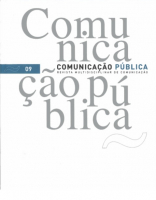Reflexão sobre um possível conceito de rádio minoritária
DOI:
https://doi.org/10.4000/cp.7647Palavras-chave:
media minoritários, migrações, etnicidade, diáspora, rádioResumo
Pretendemos com este exercício teórico fundamentar a escolha de um conceito de médio-alcance (Merton 1968) para operacionalizar um projecto de investigação sobre, concretamente, programas de rádio. Partindo da necessidade de encontrar uma designação para iniciativas no domínio dos media feitas por, para, com e/ou sobre migrantes e minorias, discutimos e refutamos conceitos frequentemente usados na bibliografia, como «ethnic minority media» (Riggins 1992) ou «diasporic media» (Georgiou 2003; Tsagarousianou 2004). Em alternativa, propomos a noção de «media minoritários», com base em discussões sobre media por vezes pensados como «secundários» (Online/More Color in the Media 2004; Dayan 1998; Sreberny-Mohammadi e Mohammadi 1994).
Downloads
Referências
Anthias, F. (1998) Evaluating ‘diaspora’: beyond ethnicity? Sociology, 32 (3), pp. 557-580.
Baumann, G. (1996) Contesting Culture – Discourses of Identity in Multi-Ethnic London. Cambridge/Nova Iorque/Melbourne/Madrid, Cambridge University Press.
Appadurai, A. (1991) Global ethnoscapes: notes and queeries for a transnational anthropology. In Fox, R. ed. Recapturing Anthropology – Working in the present. Santa Fe, School of American Advanced Research Press, pp. 191-211.
Clifford, J. (1997) Diasporas. In Clifford, J. Routes – Travel and Translation in the Late Twentieth Century. Cambridge, Harvard University Press, pp. 244-277. DOI : 10.1525/can.1994.9.3.02a00040 good / bad
Dayan, D. (1998) Particularistic media and diasporic communications. In Liebes, T. e Curran, J. eds. Media, Ritual and Identity. Londres/Nova Iorque, Routledge, pp. 103-114.
Georgiou, M. (2003) Mapping Diasporic Communities and their Media – Studying the Media, Investigating Inclusion and Participation in European Societies, European and Transnational Communities. [Internet] Disponível em http://www.lse.ac.uk/collections/EMTEL/Minorities/minorities_docs.html [consult. 18 de Julho de 2009].
Gillespie, M. (1995) Television, Ethnicity and Cultural Change. London, Routledge. DOI : 10.4324/9780203133996 good / bad
Gilroy, P. (2003) The Black Atlantic as a counterculture of modernity. In Braziel, J. E. e Mannur, A. eds. Theorizing Diaspora – A Reader. Malden/Oxford/Melbourne/Berlin, Blackwell Publishing, pp. 49-81.
Ginsburg, F. (1997) From little things, big things grow: Indigenous media and cultural activism. In Fox, R. e Stam, O. eds. Between Resistance and Revolution. Cultural Politics and Social Protest. New Brunswick/Londres/New Jersey, Rutgers University Press, pp. 118-144.
Ginsburg, F. (1991) Indigenous media: Faustian contract or global village? Cultural Anthropology, 6 (1), pp. 92-112. DOI : 10.1525/can.1991.6.1.02a00040 good / bad
Hall, S. (2003) Cultural identity and diaspora. In Braziel, J. E. e Mannur, A. eds. Theorizing Diaspora – A Reader. Malden/Oxford/Melbourne/Berlin, Blackwell Publishing, pp. 233-247.
Hendy, D. (2000) Radio in the Global Age. Malden, Blackwell.
Husband, C. (2005) Minority ethnic media as communities of practice: professionalism and identity politics in interaction. Journal of Ethnic and Migration Studies, 31 (3), p. 461-479. DOI : 10.1080/13691830500058802 good / bad
Marcus, G. (1995) Ethnography in/of the world system: The emergence of multi-sited ethnography. Annual Review of Anthropology, 24, pp. 95-117. DOI : 10.1146/annurev.an.24.100195.000523 good / bad
Merton, R. K. (1968) Social Theory and Social Structure. Londres, Collier and MacMillan.
Morley, D. (2000) Home Territories: Media, Mobility and Identity. Londres, Routledge.
Napoli, M. (2002) Audience valuation and minority media: an analysis of the determinants of the value of radio audiences. Journal of Broadcasting & Electronic Media, 46 (2), pp. 169-184. DOI : 10.1207/s15506878jobem4602_1 good / bad
Online/More Color in the Media (2004) A European manifesto to support and to underline the importance of minority community media. [Internet] Disponível em http://www.multicultural.net/ /manifesto/index.htm [Consult. 8 de Agosto de 2008].
Riggins, S. H. (1992) The media imperative: ethnic minority survival in the age of communication. In Riggins, S. H. ed. Ethnic Minority Media – An International Perspective, pp. 1-20.
Roosens, E. (1989) Creating ethnicity: the process of ethnogenesis, Frontiers of Anthropology, 5, Londres/Newbury Park/Nova Deli, Sage.
Silverstone, R. e Georgiou, M. (2005) Diasporic media across Europe: Multicultural societies and the universalism/particularism continuum. Journal of Ethnic and Migration Studies, 31 (3), pp. 481-498.
Spyer, P., Van Heeren, K. e Sushartami, W. (2002) Indonesian mediations: The re-imagining and re-imaging of community(’s) in transition – a position paper. In Nordholt, H. S e Abdullah, I. eds, Indonesia: In Search of Transition. Yogyakarta, Pustaka Pelajar, pp. 177-206.
Spitulnik, D. (1993) Anthropology and mass media. Annual Review of Anthropology, 22, pp. 293-315.
Sreberny-Mohammadi, A. e Mohammadi, A. (1994) Small Media, Big Revolution – Communication, Culture and the Iranian Revolution. Minneapolis/Londres, University of Minnesota Press.
Tacchi, J. (2002) Radio texture: between self and others. In Askew, K. & Wilk, R. eds. The Anthropology of Media: a Reader. Londres, Blackwell. pp. 241-257.
Tsagarousianou, R. (2004) Rethinking the concept of diaspora – Mobility, connectivity and communication in a globalized world. Westminster Papers in Communication and Culture. Vol. 1 (1), pp. 52-65.
Vertovec, S. (1999) Three meanings of ‘diaspora’, exemplified through South Asian religions. Diaspora 7 (2), p.p. 1-37. [Internet] Disponível em http://www.transcomm.ox.ac.uk/working%20papers/diaspora.pdf [Consult. 28 Abril 2009].
Downloads
Publicado
Edição
Secção
Licença
Direitos de Autor (c) 2010 Copyright (c) 2010 Author

Este trabalho encontra-se publicado com a Licença Internacional Creative Commons Atribuição-NãoComercial 4.0.
Os conteúdos da Comunicação Pública estão licenciados com uma licença Creative Commons - Atribuição-NãoComercial 4.0 Internacional.




